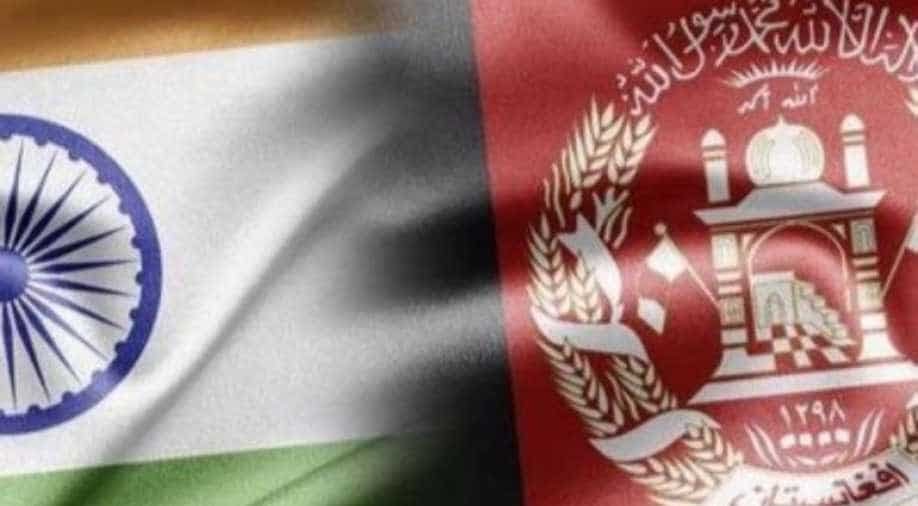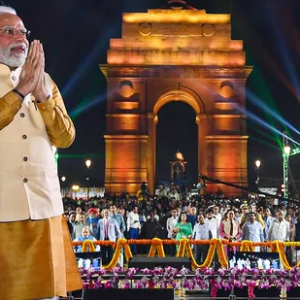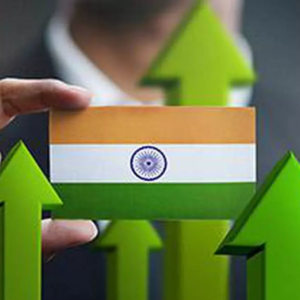Asia primarily has four regional security complexes, namely West Asia, Central Asia, East Asia and South Asia. Afghanistan occupies a location of geo-strategic importance as it lies on the periphery of all four, without merging into any of them. It is one of the few nations that remained neutral during the two world wars. Afghanistan has been more of an insulator, than a buffer, between these four complexes. Despite strong forces in its neighbourhood, it has retained its inherent characteristics of internal warlordism, cross-border terrorism and drugs trade.
The Taliban, which has now taken over Afghanistan, were earlier in power from 1996 till 2001. That rule was characterised by a harsh Islamic law, discrimination against women, providing patronage to terrorism and opium cultivation. Only three countries, Saudi Arabia, UAE and Pakistan accorded formal recognition to that government. Origins of the Taliban lie in the guerrilla training of young Pashtuns in the Pakistani seminaries in the cross-border Pashtun belt. A doctrinal mix of a more moderate ‘Pashtunwali’ and a fundamentalist Islam has resulted in an inconsistent ideology, this asymmetry being a source of a larger divide in the Taliban.
Though the Afghanistan political matrix has undergone great changes since 1973, Taliban has retained its significance therein, despite the loss of its founder leader Mullah Muhammad Omar and thousands of its cadres. Its ideology has been shaped by the regional security environment and the fact that Afghanistan is a land locked country, which makes befriending Pakistan and Iran a prerequisite for trade and survival.
Regional Dynamics
The neighbouring regions of Central Asia and West Asia, particularly West Asia, are torn by internal conflicts and intervention of major powers. They are global destabilisers. Geopolitical and security literature has termed these areas as shatterbelts[i]. Afghanistan, lying between these two regions, itself is facing a combination of civil wars and interventionist actions of other countries, often leading to great power competition.
Rawalpindi has always exercised significant financial, diplomatic and operational control over the guerrilla activities of Taliban. The Director General of Pakistan’s Inter-Services Intelligence Directorate (ISI), a military outfit, was present at the initial government formation at Kabul in September 2021. Pakistan seeks a Taliban-controlled government in Kabul to secure its western borders and keep the Durand Line quandary under control. Pakistan’s rivalry with India has prompted the latter to consider Afghanistan as a form of operational strategic depth. Afghanistan has thus become a secondary theatre of this rivalry.
The Taliban leadership is well aware of these historically adversarial relations between its former mentor, Pakistan, and its beneficiary, India. This has given the Taliban leadership a chance to take advantage of both sides. Recent incidents in the narcotics trade can be viewed from this angle. Nonetheless, this opens a window of opportunity for India.
The Taliban Leadership
The Taliban leadership council is called the Rahbari Shura or the Quetta Shura. It decides on all political and military matters and operates a shadow government through nine commissions and three administrative organs, akin to the ministries of the Taliban government. Most of the Taliban leadership are from the Mujahideen and received their schooling in Afghanistan. Their ideology, thus, is more related to the Afghan tribal way of life.
When Pakistan created the Taliban in the 1990s, inductees were mostly Pashtuns from the madrassas in the Pakistani province of Khyber Pakhtunkhwa and the Federally Administered Tribal Areas (FATA). Ideology of the new inductee Pashtuns was different from that of Afghanistan. The movement’s ideology has transformed over the past two decades from a ‘traditionalist’ Islam conforming to the concepts of Eastern Pashtun villages to one more characteristically conforming with the Arab world. Anand Gopal and Alex Strick van Linschoten, in their June 2017 paper “Ideology in the Afghan Taliban”, have made three important observations regarding dynamism of Taliban ideology[ii].
- Firstly, though the Taliban’s ideology was rooted in the pre-1979 rural South Pashtun, and did get distorted during the civil war, it was never allowed to become an alien phenomenon, or a product of extremist Pakistani madrassas.
- Secondly, the original Taliban’s ideology has undergone a metamorphosis from Pashtunwali and is now closer to the Arab form of political Islam. The objectives and methodology have shifted in important ways.
- Thirdly, the Taliban’s actions never reflected an unreasoned imitation of an ideology. They have been the result of an internal logic, reflecting a pragmatic concern for statecraft.
Taliban’s Relations with Major Terrorist Groups
The current multi-layered leadership of Taliban is a mix of war veterans from the Mujahideen and guerrilla warfare trainees of the ISI from madrassas in Pakistan. Their occupational activities have brought them in contact with other terrorist groups. Some significant linkages are as under.
- Al-Qaeda. Taliban is a nationalist movement of Afghanistan, whereas al-Qaeda has acquired a global footprint. The latter is bound to the Taliban by a pledge of allegiance, “bay’ah,” which was first offered in the 1990s by Osama Bin Laden to Mullah Omar and which has been renewed several times since, though not always publicly acknowledged by the Taliban.[iii] It is unlikely that the Taliban will sever their ties with the al-Qaeda, now that they hold power, despite the assurances given in the Doha Agreement in February 2020.
- Tehreek-e-Taliban Pakistan (TTP). The (Afghanistan) Taliban received active support from TTP which is ideologically intertwined with groups like al-Qaeda. The TTP too has pledged “Bayah” to the Afghan Taliban, which is a matter of concern to Pakistan. The TTP aims to make Pakistan a Sharia compliant state and their attacks on the Pakistani forces have intensified after Kabul fell to the Taliban.[iv]
- Islamic State. The Taliban has reportedly fought the self-proclaimed Islamic State, which is a rival of al-Qaeda and has an estimated 2,500 members in Afghanistan. Some districts in Afghanistan are reportedly under ISIS control.
- East Turkmenistan Islamic Movement (ETIM). ETIM is active in the Uighur insurgency in Xinjiang province of West China. It is said to receive training and other logistic support from Taliban.
The Taliban leadership would be under immense international diplomatic and economic pressures to terminate its narcotics trade and support to terrorist activities. Particularly in regard to the latter, external pressures separated from any domestic will, are likely to run into a blind alley. This has potential to lead to a non-optimal situation wherein aid in kind may be more readily available with a general reluctance amongst nations to transfer cash.
Foreign Policy
Afghanistan has always attracted big power attention due to its location at the confluence of multiple regional security complexes. This interest has been rekindled by the energy resources of Central and West Asia and China’s quest for a land access to the Indian Ocean. Pakistan’s influence on Taliban affairs, further complicated by the India-Pakistan rivalry, has drawn Afghanistan into a different security convolute. Taliban’s deciding to keep its released prisoners at Qatar, rather than Pakistan, appear to be a step to managing this conflict.
Taliban’s foreign policy formulation has been based on factors quite akin to those on which Afghan foreign policy has historically been devised. For successful governance of the nation, Taliban will need to address certain critical aspects in the financially bankrupt and war-ravaged nation.
- Afghanistan is a large supplier of dry fruits and has rich mineral deposits all across the country. There are currently more than 1,400 discovered mineral deposits of gems, copper, iron, ore, gold, and lithium in Afghanistan, estimated by US officials as being worth at least US $3 trillion.[v] This potential can be optimally exploited by technical collaboration with more advanced nations, which in turn will improve its trade deficit too.
- Human resource development, such as higher education facilities and integrating women into the work force will be essential. Educating a nation is costly and has a long lead time. An intermediary measure would be to seek scholarships for higher education courses in friendly countries.
- Economic infrastructure, such as roads and dams, will help usher in prosperity in Afghanistan.
- A well-equipped and trained police force is essential for governance.
All these activities require finances that Afghanistan does not have. Any income from the narcotics trade will be closely monitored by the international community. When last in power, Taliban had tried to generate a renewable source of revenue by progressing a gas pipeline from Turkmenistan to Pakistan and India with the American Unocal Corporation. This did not take off due to political and security instability. Loans from multilateral financial institutions and aid from friendly nations could provide a solution. This underscores the need to establish and maintain good relations with other nations even if it runs contrary to its earlier core ideology.
India’s Concerns
India’s core strategic interests in Afghanistan lie in regional stability and development without external interference. A stable, democratic Afghanistan that is relatively modernist and inclusive would minimise external interference in the country, thereby avoiding geopolitical imbalances in the region. It would also open up the region for flow of energy resources from the oil and mineral-rich Central Asian Republics through pipelines, which would benefit India besides other stake holders. How that is to be achieved would remain a challenge for India, especially with the Taliban government.
A core interest for India would be an Afghanistan that does not become a haven for terrorist groups from across the world. The eradication of all terrorist activities emanating from the region is hence a priority for India, which includes state-sponsored terrorist nurseries and havens along either side of the Durand Line. In a May 2020 statement, the Taliban disassociated itself from the Kashmir insurgency[vi]. That statement reversed the Taliban’s past ardent opposition to Indian presence in Kashmir by terming the Kashmir situation as a ‘domestic issue of other countries that the movement did not seek to interfere in’.[vii] Whether the Taliban sticks to this commitment remains to be seen.
Pakistan’s quest for strategic depth in Afghanistan would not affect India strategically as Pakistan’s internal fault lines will deny it success. Pakistan’s commitment to the Sunni cause in Afghanistan has led to violence against its own Shia minority—a strategic error that is potentially of the same gravity as that which cost it East Pakistan, now Bangladesh.
India’s Aid Paradigm
Afghanistan needs sustained external aid to develop in its preferred areas. International aid is generally directed towards the donor nation attaining economic, political or security benefits; however, a pillar of New Delhi’s aid to Kabul has been development partnership. This aid is formulated primarily on basis of Kabul’s stated needs.
India, as the sixth largest donor to Afghanistan, has given over US $ 4 billion aid in the last two decades. It has built more than 2,500 miles of roads, which includes the 218-kilometer Zaranj-Delaram Road to the Afghanistan-Iran border for facilitating movement of goods and services to the Iranian port at Chabahar. This highway, completed in 2010, connects Iran with the Garland Highway, which links Kabul, Kandahar, Mazar-e-Sharif, Herat and Kunduz. It has built the Afghanistan-India Friendship Dam (AIFD), also called ‘Salma Dam’, in Herat District, hydropower plants, electricity transmission lines, hospitals, schools and the country’s new parliament building. Three major characteristics of Indian aid are that it is bereft of any strings attached, overheads are minimised by use of its existing structures and it is provided as per the end-use determined by Kabul.
Where India goes from here, after the Taliban takeover, will depend to a large extent on the type of government the Taliban runs. In February 2020, the Taliban’s political spokesman, Suhail Shaheen, told Turkey’s Anadolu News Agency that the Taliban has “no issue with any country”. Then on 26 August 2021, in an interview to the News Channel CNN-News 18, the same spokesperson candidly stated that the Taliban would be happy if India completed the ongoing projects and would welcome any new projects which were for the welfare of the people.[viii] How this ultimately pans out is yet to be seen, but it would be prudent to keep in mind the fact that the Taliban government in power is not inclusive and is largely controlled by the Haqqani Network, which in turn is beholden to Pakistan. So further assistance by India will depend on how the situation in Afghanistan evolves.
India’s Afghan Policy and Future Options
New Delhi has consistently supported a strong, democratic and violence free Afghanistan due to the latter’s insulator status between the four regional security complexes of Asia. Afghanistan is party to dominant conflict in South Asia and has pronounced significance to peace and stability in the region. Its inclusion in SAARC in 2007 was promoted by India in order to expedite its strategic integration into the South Asian regional order. The current situation In Afghanistan provides India the opportunity at international power projection, as all major powers have a stake in the manner the Afghan situation pans out. The cost of engagement has to be seen in the context of the cost of non-engagement, so some form of outreach to the Taliban may be inevitable, though this does not mean formal recognition of the government. Indian would need to closely watch the growing congruence between the Taliban and Pakistan, as also the forays that China may make in Afghanistan to pursue its economic interests.
The Indian response will have to be based on how the situation evolves. Should Afghanistan slip into civil war, then Indian support to forces that desire an inclusive government and who bat for gender equality will perhaps be on the cards. Russia is already concerned with the growing threat of the spread of radicalism in Afghanistan, which would have negative spillover effects on the Central Asian Republics and thence to Russia’s Muslim population. Towards this end, a joint exercise of the Collective Security Treaty Organisation (CSTO) called Rubezh-2021 was held in Kyrgyzstan in early September in which military personnel from Kazakhstan, Kyrgyzstan, Russia and Tajikistan took part. The exercise focused on the preparation and conduct of hostilities to destroy illegal armed groups that invade CSTO member state’s territory. Iran too is deeply concerned with the sectarian killings that have taken place through a spate of suicide attacks on Shia Mosques.[ix] India could coordinate its efforts in such a scenario with Russia, Iran and the CAR’s.
India could also support a UN mandated intervention under Chapter VII of the UN Charter. But as this would be a peace keeping force and not a force for peace enforcement, its utility would be negligible. In any case, the Taliban will not accept outside forces on its land, making this option a virtual non-starter.
A more pragmatic and doable approach for India would be to support efforts at providing humanitarian assistance to the people of Afghanistan. Prime Minister Modi spoke of this in the G-20 meeting,[x] calling for assistance based on UN Resolution 2593[xi] of the 15-member Security Council, which demanded that Afghan territory not be used to threaten or attack any country, reiterated the importance of combating terrorism in Afghanistan and for providing unhindered access for the United Nations and its agencies to provide humanitarian assistance to Afghanistan. Here, the United Nations Assistance Mission in Afghanistan (UNAMA) would have a central role in providing assistance and would give India a much needed say in assisting Afghanistan’s return to stability.
On the negative side, with the current dominant role being played by Pakistan in Afghanistan, Indian efforts to restore stability will be hindered by Pakistan. Would USA, Russia, China and Iran be able to dissuade Pakistan from playing a spoiler, would have to be seen, but should that happen, it could make a significant impact on restoring stability in Afghanistan.
Author Brief Bio: Maj Gen Harkirat Singh is an Alumnus of Sherwood College, Nainital, National Defence Academy and National Defence College, New Delhi. A veteran of India’s strategic forces operations within the country and abroad, he has been a resource person for geo-strategy at national universities.
References:
[i] A feature of the contemporary world geopolitical map, the “shatterbelt”, was especially prominent during the cold war. Shatterbelts are regions torn by internal conflicts whose fragmentation is increased by the intervention of external major powers in contention over the region. They are global destabilisers. Also see “Geopolitics of the World System”, Saul Bernard Cohen, Rowman & Littlefield Publishers Inc, Oxford, UK, 2003, p 5-42, pp 436.
[ii] Anand Gopal and Alex Strick van Linschoten, “Ideology in the Afghan Taliban”, Afghanistan Analysts Network, June 2017. Details at https://www.afghanistan-analysts.org/wp-content/uploads/2017/06/201705-AGopal-ASvLinschoten-TB-Ideology.pdf . Viewed on 02 Aug 2020
[iii] https://www.bbc.com/news/world-asia-58473574
[iv] https://www.indiatoday.in/world/story/al-qaeda-taliban-pledge-pakistan-1851361-2021-09-10
[v] https://www.files.ethz.ch/isn/167207/Economic%20Growth%20opportunities%20in%20Afghanistan%20final.pdf
[vi] “Taliban Praises India for Resisting US Pressure on Afghanistan”, Press Trust of India, The Hindu, New Delhi, 17 June 2012. Also see https://www.thehindu.com/news/international/taliban-praises-india-for-resisting-us-pressure-on-afghanistan/article3539512.ece
[vii] “Kashmir is India’s Internal Matter, says Taliban; Denies Plan to Target Delhi”, Shishir Gupta , Hindustan Times, New Delhi, 19 May 2020. Also see https://www.hindustantimes.com/india-news/kashmir-is-india-s-internal-matter-says-taliban-denies-plan-to-target-delhi/story-sOgG3yPsMenP4nZDKRbygL.html.
[viii] https://www.news18.com/news/world/exclusive-taliban-seek-foreign-aid-to-rebuild-nation-after-20-years-of-war-have-special-message-for-india-4126862.html
[ix] https://www.bbc.com/news/world-asia-58925863
[x] https://www.ndtv.com/india-news/united-global-response-needed-to-bring-desired-changes-in-afghanistan-pm-2573239
[xi] https://www.un.org/press/en/2021/sc14620.doc.htm



